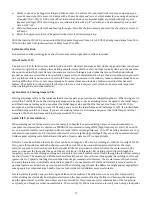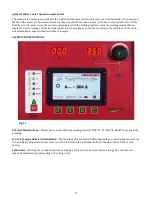
25
Fig. 39
Fig. 40
Fig. 41
When setting post-gas flow, more is better—especially
when in doubt. How much post-gas flow you need
depends on the material you plan to weld, the cup you
plan to use, the amperage you plan to weld at, and the
amount of tungsten stick-out you use. Some people
advocate that you never need more than 5 seconds of
post-gas flow, claiming that more post-gas flow is just a
waste of Argon. Well, let’s put it this way. At a bare
minimum, you need to keep the tungsten electrode
shielded until the tungsten is cold enough to where it
does not react with the ambient air. What does that
mean? If the shielding gas stops when the tungsten
electrode is still too hot, you will most likely see gray or
even black discoloration of the tungsten, which is very
bad! After you finish welding, the tungsten should be the
same shiny silver color that it is when it was brand new.
If you weld stainless or even titanium, post-gas flow
times of 30 or 60 seconds, and sometimes longer
depending on the amperage, are not unheard of. During
post-gas flow time, you also need to hold the torch in
position to shield the metal from discoloring.
By pressing button
E
(
Fig. 11
; the down arrow in this
instance) you get deeper into the TIG - MAIN SETTINGS
submenu.
The Invertig 313/400 allows you to adjust TIG hot-start
in both AC and DC. Most other TIG welding machines,
and all other high-end, brand name welding machines,
feature a hot-start function that delivers a factory pre-
set amount of hot-start, for a predetermined amount of
time (typically in the range of several dozen or several
hundred milliseconds). Some competitive machines
allow you to preselect a tungsten diameter, which will,
in some cases, change the hot-start parameters of the
machine. The downside to this is that there is always
hot-start, and, although all TIG machines have a
minimum amperage listed in the literature, they never
actually start an arc at that amperage since hot-start
cannot be turned off.
Why is this so important?
On very thin material the
ability to adjust hot-start way down, or even turn it off,
can be a huge advantage. Some find it helpful to light the
arc on a piece of filler rod resting on the work piece so
they don’t burn through. Others use run in tabs. With the
ability to adjust the hot-start parameters, those tricks
become things of the past.
If a low hot-start is such a great thing, then why did
we make it adjustable from Off or from 4 to 130
amps?
Sometimes, depending on the size and type of tungsten
you use (the Invertig welds best with 2% Ceriated
tungsten), and, depending on whether you are welding in
AC or DC and potentially collected a fair amount of
aluminum oxide on the tungsten, you may find re-
striking an arc hard after welding for awhile. In this case,
you might need a higher starting amperage all together.
But, first and foremost, you need hot-start, and plenty of
it, to initially ignite the arc. With that being said, most
competitive machines with non-adjustable hot-start
generally have too much hot-start rather than not
enough, which can make welding thin materials
challenging.
As a good starting point for welding in DC, we suggest
around 40 amps of hot-start for small diameter
electrodes and around 70 amps of hot-start for large
diameter electrodes. As a good starting point for welding
in AC, we suggest around 60 amps of hot-start for small
diameter electrodes and around 100 amps of hot-start
for large diameter electrodes.
Now, on an initial, freshly ground arc start, hot-start
most likely can be turned off completely (
Fig. 41
). Also,
clean tungsten electrodes require less hot-start than
contaminated electrodes.












































